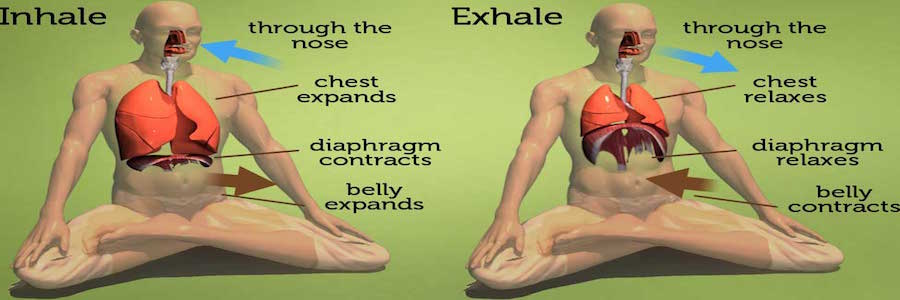
If your goal is to increase core strength, stabilize your spine, and decrease low back pain – then diaphragmatic breathing must be part of your training program.
I often hear low back pain sufferers talk about how their Chiro, MD, PT, trainer, next door neighbor, told them their weak core is the source of their pain. This is good information-and most likely true-however, there is conflicting and incomplete information given as to how to increase core strength and subsequent spinal stability. One of the missing links to a strong core is the diaphragm; the muscle used to breathe.
The Core
The core is basically a muscular dome in the abdomen made up of spinal stabilizers in the back, several layers of abdominals in the front and on the sides, the pelvic floor muscles on the bottom, and the diaphragm, which makes up the top of the dome.
The Diaphragm’s Role
The function of the diaphragm is the rhythmic raising and lowering of the ribs in response to pressure and volume changes created by the lungs. When a person takes a deep breath, the diaphragm lengthens, depresses, and allows the lungs to expand. The diaphragm is then contracted to forcefully expel air from the lungs and respiratory system. This process is basically done on auto-pilot.
Accessory Breathing
However, when a person sits for hours on end with poor, slumped posture, the diaphragm can no longer perform it’s job the way it was designed to do and it basically becomes dormant. When this happens, the brain panics and finds another way to keep you breathing. It starts to facilitate the secondary breathing muscles and use them as primary breathers. The person has now become what’s called a “chest breather”, where the secondary breathing muscles that attach to the upper ribs and neck work to increase chest expansion instead of abdominal expansion. We can keep breathing, and life continues as normal.
The problem with this is, these muscles have other jobs relating to the head, neck, jaw, and upper ribs. When muscles start compensating and become over-worked for extended periods of time, something has to give…this is one of the reasons we see people with their heads 6 inches in front of their shoulders. For the sake of not rambling and staying on topic, I won’t get into other causes and complications of forward head posture. Today the problem child is the diaphragm.
Avoid the Crunch
Obviously we have established that the diaphragm is important for- you know – living. If the diaphragm is a synergistic core muscle, it needs to be used and strengthened in order to have complete core strength and stabilize the spine. I often ask my clients what they are doing to strengthen their core and they usually respond with some variation of a crunch. Crunches on the floor, crunches on a Bosu ball, hanging leg raises (which are basically just fancy, suspended crunches) – these exercises only target ONE of the core muscles I mentioned above, and exactly zero of them are doing breathing exercises to facilitate the diaphragm. Not to mention, it has been shown that repetitive crunches do some pretty serious damage to the discs, but again we’re focusing on the diaphragm today.
If the goal is to increase core strength, stabilize the spine, and decrease low back pain, diaphragm breathing must be part of your rehab program. For more information about this topic, or to get your diaphragm assessed by our own skilled chiropractor, Dr. Chelsea Rackham, call (972) 638-8545 or contact us to set an appointment.
Here’s a link to an interesting article in the International Journal of Sports Physical Therapy if you would like to read more about this topic. BREATHING PATTERN DISORDERS AND FUNCTIONAL MOVEMENT
If you want us to help you strengthen and stabilize your core, Talk to us or call us at 469-619-7499